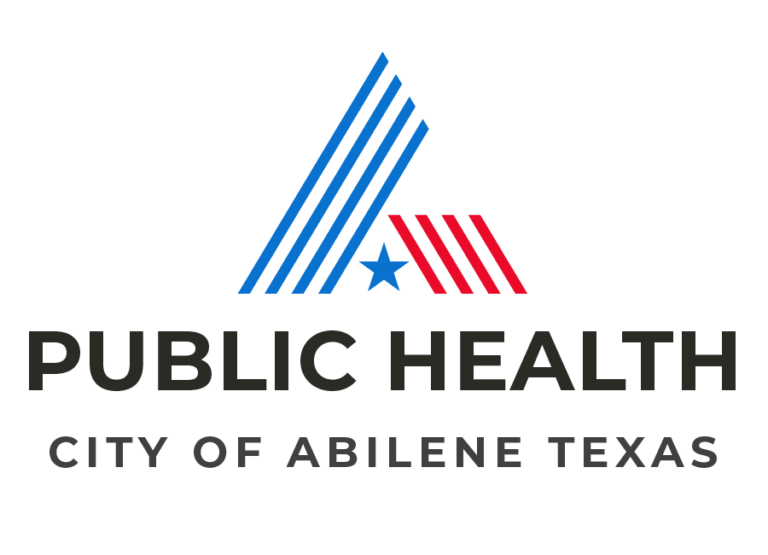Community Data
High Cholesterol Prevalence
Quick Facts:
- High cholesterol doesn’t have any symptoms, so without a blood test to check cholesterol levels, you may not know that your cholesterol is too high.
- In the U.S. 7% of children have high cholesterol.
- As of 2019, 34.8% of Texas adults were diagnosed with high cholesterol, compared to the 33.3% of U.S. adults diagnosed with high cholesterol in 2019.
What is High Cholesterol?
Cholesterol is something that everyone has, and is found in everyone’s body. However, when cholesterol builds up this leads to High Cholesterol (Hyperlipidemia), and becomes a medical condition. Once cholesterol levels become high, then fatty deposits can develop within your blood vessels. The deposits can increase in size, causing less blood flow. In addition, the deposits can break off and form a blood clot that can lead to more serious conditions. There are two main types of cholesterol, and this depends on the proteins they attach to in your body:
- Low-density lipoprotein (LDL) – this is referred to as the “bad” cholesterol. This is the type of cholesterol that builds up in the arteries.
- High-density lipoprotein (HDL) – known as the “good” cholesterol. This type brings back extra cholesterol in your body and takes it to the liver.
Risk factors for high cholesterol include:
- Obesity
- Poor diet
- Lack of exercise
- Smoking, alcohol, or chronic stress
- Additional medical conditions, like hypertension or diabetes
High Cholesterol in Our Community
Darker colors on the interactive maps indicate worse outcomes.
In 2017, it was estimated that 34.3% of Taylor County adults were diagnosed with high cholesterol. This percentage was higher than the estimated percent of adults in Texas who had high cholesterol, which was 31.7%. The percentage of Taylor County residents who had high cholesterol slightly decreased by 2019 to 32.0%. This was slightly lower than the estimation of Texan adults who had high cholesterol, which was 32.9% in 2019.
In Taylor County, the zip codes with the highest percentage of adults diagnosed with high cholesterol were 79566 (43.4%) and 79561 (38.9%). The zip codes with the lowest percentage of adults diagnosed with high cholesterol were 79607 (12.4%) and 79601 (29.0%).
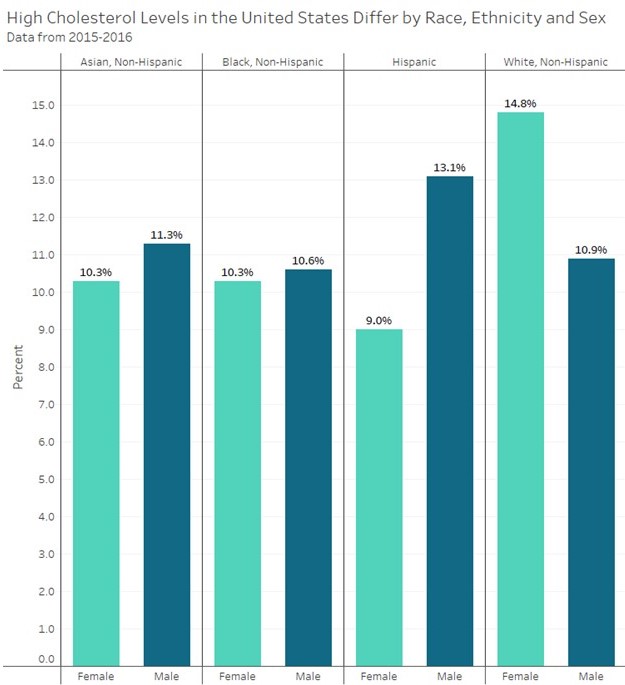
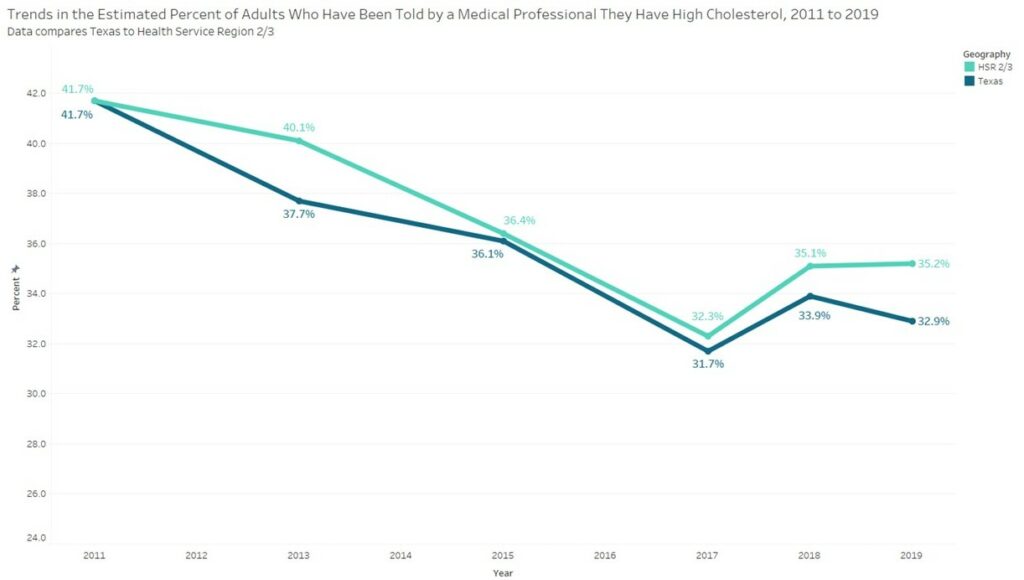
Community Data
High Cholesterol Screening
Quick Facts:
- About 2 out of every 3 Americans say that their cholesterol levels have been checked within the past 5 years.
- In 2019, 85.9% of Texas adults reported having their cholesterol screened within 5 years, whereas 86.6% of U.S. adults had a cholesterol screen in the past 5 years as of 2019.
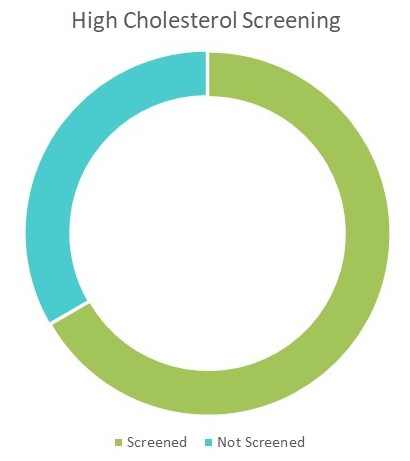
High Cholesterol Screenings
Your primary care physician can do a simple blood test to measure cholesterol levels. Cholesterol screenings are recommended for healthy adults every 4-6 years. For those with additional chronic illnesses such as high blood pressure and diabetes, high cholesterol screenings will be done more often. A conversation with a primary care physician will assess risk, and determine how often cholesterol screening should be completed.
High Cholesterol Screenings in Our Community
Darker colors on the interactive maps indicate better outcomes.
In 2017, approximately 82.7% of Taylor County residents had been screened for high cholesterol levels within the previous 5 years. This estimated percentage decreased slightly by 2019 to approximately 82.0%.
Among Taylor County zip codes in 2019, there were 6 zip codes where about 9 out of every 10 residents had been screened for high cholesterol within the past 5 years. Most of these zip codes were at the southernmost part of Taylor County and were 79566 (94.0%), 79541 and 79530 (92.1%), 79508 (91.9%), and 79562 (91.3%). The 6th zip code with a high percentage of cholesterol screening among residents was at the northwestern end of Taylor County and was the zip code of 79561 (89.8%). The zip code with the lowest percentage of adults who had been screened for high cholesterol was 79699 (70.9%) and 79607 (76.6%).
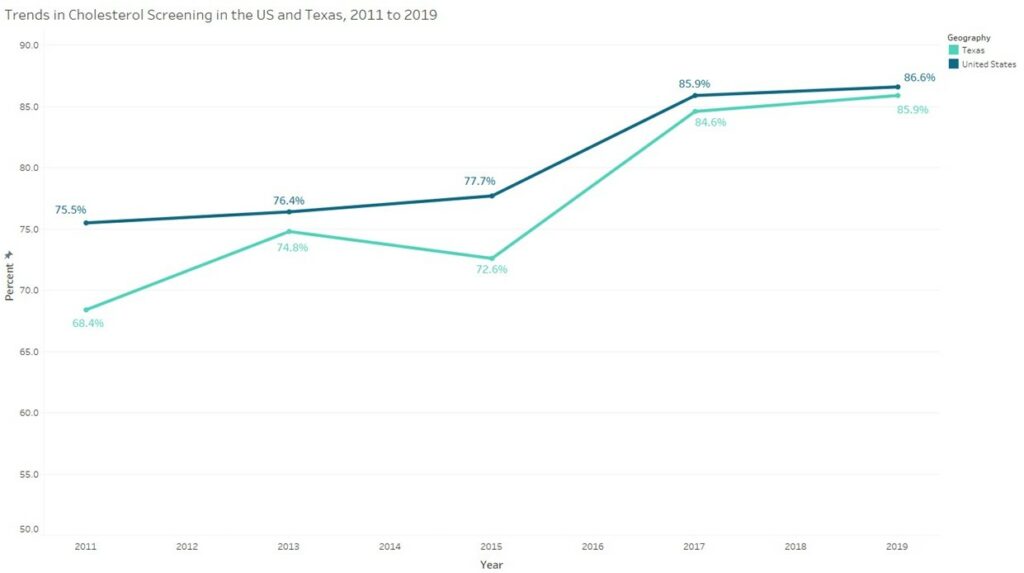
Click for Data Sources
- Centers for Disease Control and Prevention. (2021, June 24). About Cholesterol. Centers for Disease Control and Prevention. Accessed May 5, 2022 from https://www.cdc.gov/cholesterol/about.htm
- Texas Department of State Health Services. Texas Health Data: Behavioral Risk Factor Surveillance System (BRFSS). Texas.gov. Accessed May 10, 2022 from https://healthdata.dshs.texas.gov/dashboard/surveys-and-profiles/brfss
- CDC, National Center for Chronic Disease Prevention and Health Promotion, Division of Population Health. PLACES: County Data (GIS Friendly), 2021 release. https://chronicdata.cdc.gov/500-Cities-Places/PLACES-County-Data-GIS-Friendly-Format-2021-releas/i46a-9kgh
- CDC, National Center for Chronic Disease Prevention and Health Promotion, Division of Population Health. PLACES: County Data (GIS Friendly), 2020 release. https://chronicdata.cdc.gov/500-Cities-Places/PLACES-County-Data-GIS-Friendly-Format-2020-releas/mssc-ksj7
- CDC, National Center for Chronic Disease Prevention and Health Promotion, Division of Population Health. PLACES: ZCTA Data (GIS Friendly), 2021 release. https://chronicdata.cdc.gov/500-Cities-Places/PLACES-ZCTA-Data-GIS-Friendly-Format-2021-release/kee5-23sr
- Centers for Disease Control and Prevention. (2020, September 8). Getting Your Cholesterol Checked. Centers for Disease Control and Prevention. Accessed May 5, 2022 from https://www.cdc.gov/cholesterol/cholesterol_screening.htm
- Texas Department of State Health Services. Texas Health Data – Behavioral Risk Factor Surveillance System (BRFSS). Texas.gov. Accessed May 10, 2022 from https://healthdata.dshs.texas.gov/dashboard/surveys-and-profiles/brfss
- Centers for Disease Control and Prevention. BRFSS Prevalence & Trends Data. Nccd.cdc.gov. Accessed May 10, 2022 from https://www.cdc.gov/brfss/brfssprevalence/index.html
- CDC, National Center for Chronic Disease Prevention and Health Promotion, Division of Population Health. PLACES: County Data (GIS Friendly), 2021 release. https://chronicdata.cdc.gov/500-Cities-Places/PLACES-County-Data-GIS-Friendly-Format-2021-releas/i46a-9kgh
- CDC, National Center for Chronic Disease Prevention and Health Promotion, Division of Population Health. PLACES: County Data (GIS Friendly), 2020 release. https://chronicdata.cdc.gov/500-Cities-Places/PLACES-County-Data-GIS-Friendly-Format-2020-releas/mssc-ksj7
- CDC, National Center for Chronic Disease Prevention and Health Promotion, Division of Population Health. PLACES: ZCTA Data (GIS Friendly), 2021 release. https://chronicdata.cdc.gov/500-Cities-Places/PLACES-ZCTA-Data-GIS-Friendly-Format-2021-release/kee5-23sr


